Savory Watermelon Summer Salad
- At July 24, 2020
- By megan
- In arugula, basil, Farm to Table, favorites, gluten-free, lime, mint, olive oil, Recipes, salad, shallots, side dish, watermelon
 0
0
THIS is what summer dreams are made of!
I love watermelon- grilled, juiced, frozen into ice cubes for cocktails- it’s versatile. A savory summer salad is a fun way to enjoy the quintessential summer melon.
For this recipe I used a small seedless watermelon, so it made enough for 5 or 6 side salads. Just serving two people? Cut back, or make the whole thing and eat it over a few days. I seasoned and “dressed” the watermelon separately and then assembled the salads individually so none of the greens were left soaking in the citrus juice. There are also a lot of possible substitutions: Don’t have arugula? Spinach could work. No shallot? Try a red onion. No idea what cotija cheese is? Try a chevre or feta cheese. It’s versatile, so play around and enjoy something new.
Ingredients
- One seedless watermelon
- juice of 2 limes
- 1/2 shallot, finely chopped
- 1 teaspoon paprika
- Arugula
- basil
- mint
- squash blossoms
- cotija cheese
- olive oil
- salt
- pepper
Cut up the watermelon into bite sized cubes. Add the chopped shallot, squeeze lime juice on top, sprinkle paprika, and toss to coat. Portion into a bowl and add some arugula, basil, mint, slices of squash blossoms if you have them, and some cotija (or feta) cheese. Drizzle some high quality olive oil and salt and pepper to taste.
Enjoy!
Grilled Peaches and Grilled Watermelon: Yes, it’s dinner.
- At August 17, 2019
- By megan
- In BBQ, Cheese, Farm to Table, Grilled, local foods, peach, Recipes
 0
0
Peach season is upon us and despite eating them at almost every stop on my food tours with Local Table Tours, I still can’t get enough of them! Palisade peaches and Rocky Ford watermelon are in my house and so they wound up on the grill for a simple dinner of grilled peach and grilled watermelon with massaged (local) kale, quinoa with ancient grains, and toast… but not just any toast- orange zest and honey butter toast. Top it off with a little chevre and you have dinner.
Here’s what I did for this super simple meal-
I cut kale into long, thin strips known as a chiffonade cut, drizzled it with olive oil and sea salt, and massaged it for a couple minutes. Then I set this aside to soften and didn’t come back to it until it was time to eat. On the stove I cooked a quinoa/ancient grain blend according to directions and let that sit to cool to room temperature as well.
Next, I mixed a couple tablespoons of olive oil with a few teaspoons of honey, juice of 1/3 of an orange, and a nice heap of orange zest. I brushed this over the watermelon and peaches before grilling them.
Peaches and watermelon only need to be grilled for a few minutes on each side since they’re delicate and full of water.
The grilling process brings out their sugars and makes them taste a little sweeter, but not too sweet that they can’t be the star of the show on the dinner plate.
While the watermelon and peaches were grilling I mixed a little honey and orange zest with softened butter that I spread over both sides of my bread.
My tiny charcoal grill can only handle so much at a time, so when the watermelon and peaches were done, the bread went on for a few minutes on each side.
The texture of grilled watermelon will fool you into thinking you’re enjoying a steak. Well, not really. But it’s a hell of a lot healthier for you 🙂
Give it a try. Summer isn’t over yet!
Apple Pie Filling & Cabbage Stew
- At November 4, 2018
- By Sean Smith
- In Apples, cabbage, Farm to Table, pie, Recipes, Soup
 0
0

Everyone has their favorite fruit, or at least should. Some people go gaga for watermelon. Others say bananas are the best. Oranges may rank at the top for just about anyone. Me, I really can’t say I have a favorite. I know which ones I don’t care to consume unless they are presented in a interesting way, which would be melons and figs. Something about the mustiness flavor of both throws me off. But a few slices of watermelon with ricotta, cracked pepper and a drizzle of extra virgin olive oil is divine. A fig compote topped on a nicely grilled pork chop is a party in your mouth. Having the diverse palate that I have I swing from the strange, exotic stuff like say horned melon to the more basic items like strawberries. Oh wait that’s not a fruit technically.
Which leads me to this post. I don’t know if it’s being born and raised in New England or the fact that there are so many culinary ways of using them but apples place at the top of my favorites. I can’t even begin to to list how this humble group can transform an ordinary dish to something stellar. Not to mention if you find yourself at a farmers market they should have heirloom varieties that will fit any which way your mouth desires. Of course, an American tradition, especially this time of year, is Apple Pie. Now the recipe that follows is for canning the filling, saving that fall flavor for later in the winter. If you’re in dire need of a recipe for a pie that needs to go in the oven ASAP, message me and I’ll be happy to give you one. Otherwise, get out there, pick your own from a local farm, stop buy a booth at a farmer’s market, which may be ending this time of year, or head to grocery store to snag some. Just remember, don’t buy “Red Delicious” as they are never delicious and they are definitely not the apple of my eye.

APPLE PIE FILLING
- 5 #’s Apples
- 6 C water
- 1 1/2 C sugar
- 3 sticks Cinnamon
- 1 T freshly ground Nutmeg
- 3 T Corn Starch
- 3 T Citric Acid
- 1 t Salt
- juice of 1/2 Lemon
You’re going to want to start the “brine” before you start peeling the apples. Apples will brown quickly due to oxidation so peeling and slicing them should be the last step. Combine the water, sugar, cinnamon and nutmeg and bring to a boil. Reduce heat and simmer for 15 minutes. This will really help the aromatics infuse into the liquid. Mix the corn starch into just enough water to make it pourable. When the timer goes off, pour the slurry into the pot, whisk and bring back to a boil. Cook for a minute or two whisking to make sure there is no clumps and remove from heat.
Next up is peeling and cutting the apples. Firstly, combine the citric acid with the salt and lemon juice, if you can’t find citric acid, increase the amount of lemon juice to a whole lemon. If you feel good about using a paring knife to peel the apples, you should as the ribbon of skin will come in handy for the next recipe. If not, a regular peeler will work but save the skins of either! Don’t peel all the apples at once, do it in several batches to avoid them turning brown before being cut. In my experience, most everyone who’s eating apple pie is just happy to be eating apple pie and not looking to see how pretty it is between shoveling it down their throat. Add the apple to the citric and lemon, give them a gentle toss and repeat until apples are gone.

Split the apples between 3 quart jars, packing them in but not mushing the fruit. Any remaining pieces set aside for later. Pour the spiced liquid over the apples, remembering to leave enough head space. If you like, save any leftover liquid to make an alcoholic beverage with later. It would be an excellent mixer for a warmed whiskey drink but would also be fantastic thinned out with some hot water for a relaxing drink on a cold Autumn night.
Follow the general guidelines for canning for your altitude.
Now if you’re still reading this, thank you firstly and secondly, you deserve a bonus recipe. “Cabbage Stew” may not sound that sexy but it’s a really tasty dish. Not to mention it’s hearty, quick to make and freezes well for future use. So let’s get to it!
CABBAGE STEW
- 1 medium Yellow Onion, diced
- 3 Carrots, diced
- 2 stalks Celery, diced
- 4 cloves Garlic, sliced
- 1 medium to large head of Green Cabbage
- 28oz can diced tomatoes
- 3 T dried Oregano
- 2 T dried Parsley
- 2 Bay Leaves
- leftover apple pieces and skins
- 3 T olive oil
- water
- salt to taste

If you’re using leftover apple pieces, give a quick rinse to get off the citric acid & lemon juice. Over medium high heat in a large pot warm the olive oil in a large pot. Add the onion, carrot, celery and garlic and stir frequently for a few minutes. Add in a about a cup of water and bring mixture down to a simmer. Now I should say that if you’d like to use stock instead of water, feel free to but I would stay away from anything except vegetable stock as the flavors of others may not work with this stew. While your mirepoix is softening, cut your cabbage into quarters, removing only the thickest part of the stem. Using the slicer blade on the food processor, add each quarter. If your cabbage is especially large, there may need to be some more downsizing done to fit in the chute. In between each segment, shred a handful of apple peels and mix with the cabbage. Once this part is done add in the cabbage/apple mixture, apple pieces, tomatoes and herbs to the pot. Follow that with enough water (or stock) to cover the stew. You don’t want too much liquid as the cabbage is going to kick out some juice as it cooks and you can always add in more during the cooking process. Turn heat up and depending on how much time you have, or really how hungry you are, simmer or low boil until the cabbage is al dente. Serve with a nice piece of crusty bread and maybe a little bit of grated parmesan on top.
Roasted Cinderella Pumpkin
Chef asked me to swing by the Munson Farm Stand for a Cinderella pumpkin he could roast and preserve for the winter. I LOVE pumpkin, so I was really happy he wanted to preserve some this year. I usually buy a few pie pumpkins to make my pumpkin peanut curry soup, and they’re much smaller- maybe smaller than a soccer ball. The selection of Cinderella pumpkins at Munson’s Farm Stand was impressive, and this one was larger than two of my heads put together.

Sean almost effortlessly sliced it in half. I would have needed a saw, I think.

Scooped out the seeds…

Drizzled olive oil on top and then some salt and pepper…

And then they BARELY fit into our miniature oven. We live in 600 sq ft, and our kitchen appliances reflect that. But, we shoved it in there and made it work.
It roasted at 450 for more than an hour and didn’t quite come out as brown as we had hoped, but that’s sometimes what happens with miniature appliances- the end product isn’t as perfect as it could be. It still tasted great, so that’s really all that matters.

We let it cool and then scooped out A LOT of pumpkin.
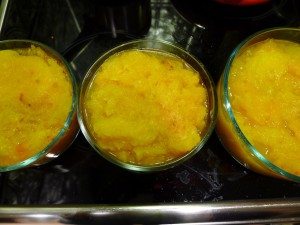
Sean then pureed it in the Vitamix, poured it into jars, and processed it to save it for a wintery day. It’s truly wonderful to be married to a chef who likes to cook at home.

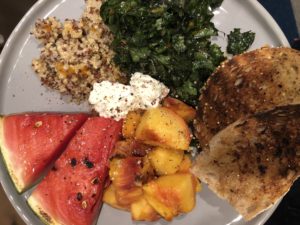
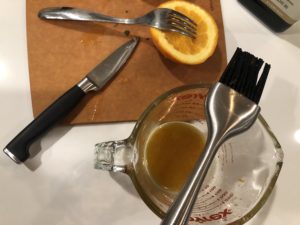


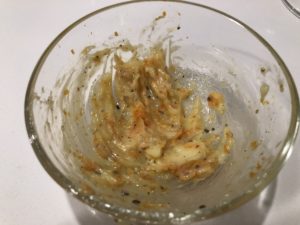
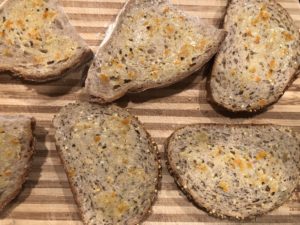
Let’s get Social